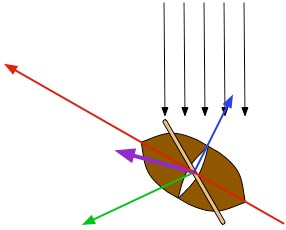It is possible to sail into the wind. In other words, if the wind is coming out of the north, it is possible to sail due north. This process, however, is slow and difficult, and can only be done with a properly equipped boat. Here's a diagram showing how it’s done:

The wind is coming down from above, represented by the black arrows. The ship’s hull is pointed along the direction of the red arrow, and its sail is represented by the tan line. Now, if you rig the sail properly, the ropes on it will pull the ship in the direction indicated by the green arrow. In other words, the wind will push the ship sideways and downwind. However, the ship’s keel acts like a sail, too, only it’s a sail against water, and water is 800 times denser than air. So the ship really can’t go in the direction of the green arrow; the water in effect provides a push in the direction shown by the blue arrow. When you add the wind’s push and the water’s push together, you get a net result as shown by the thick purple arrow. It’s not a big push, but it is definitely into the wind. So you sail for an hour or so in this direction, and then you reverse the process, flipping over so that instead of sailing upwind to the left, you sail upwind to the right. Thus, you zigzag your way forward. Yes, it’s slow and cumbersome, but it’s still a lot easier (and faster!) than rowing.
In order to tack efficiently, you need four things:
- A deep keel. The keel is the sail for the water, and a deep keel acts like a tall sail. Have you ever noticed that racing sailboats have special underwater fins that go much deeper into the water than the hull? They’re rather like keel-extenders; or perhaps you can think of them as water-sails.
- A port that can accommodate your deep keel. Throughout the Bronze Age there was no such thing as ports as we think of them. You rowed your boat up to the beach and ran into the sand; then the crew hopped out and pulled the boat up further onto the beach so that it wouldn’t wash away on a big wave. That was all there was to do with flat-bottomed boats. But you couldn’t do this with a deep-keeled boat. It’s rather like the early days of aviation, when planes could take off and land from any smooth grassy field. The wide body jets we use these days can’t do that; they need special airports with long, wide, smooth runways and all sorts of electronic stuff to guide them in. The development of aviation required the development of better airports; in the same way, the development of navigation required the development of better seaports that permitted ships with deeper keels to be brought right up to the pier to be loaded and unloaded. This task required centuries.
- Rigging. Hanging a sheet from a mast is fine if you’re always going to sail downwind, but if you want to tack, you need lots of rope that you can quickly re-arrange to tilt the sail relative to the wind, while still insuring that the force of the wind is transmitted to the ship in the right direction. It took lots of time to refine these arrangements.
- Expertise. People had to figure out how to do all this stuff; it’s pretty tricky. The trickiest part is the task of reversing the direction of the sail so that you switch from going upwind to the left to going upwind to the right. It’s easy to screw up this step and lose a lot of ground. So you needed not only sea captains who knew how to do it, but also sailors who understood their task well. Building up a big supply of skilled sailors took a long time.
These reasons explain why sailing took so long to replace oar-driven navigation.
